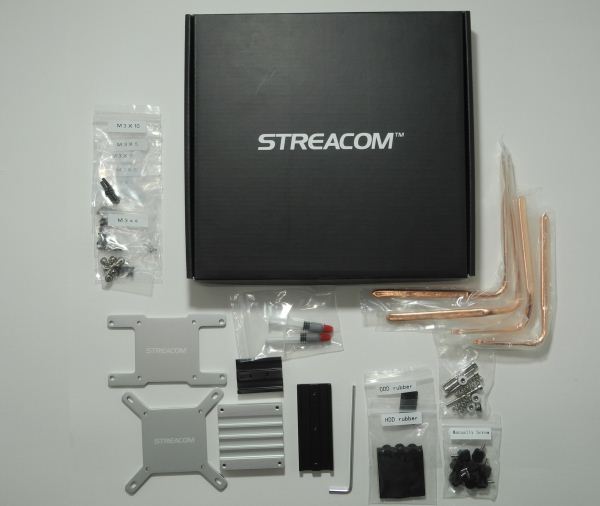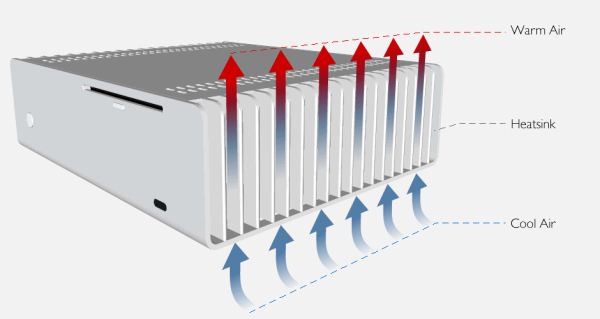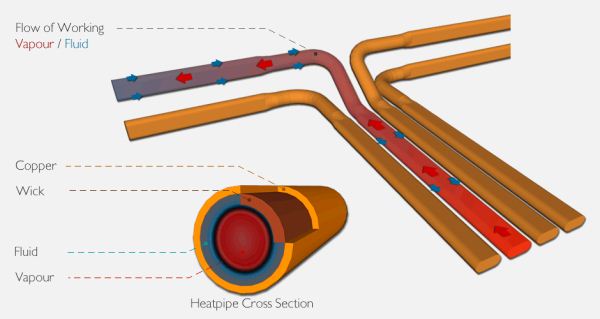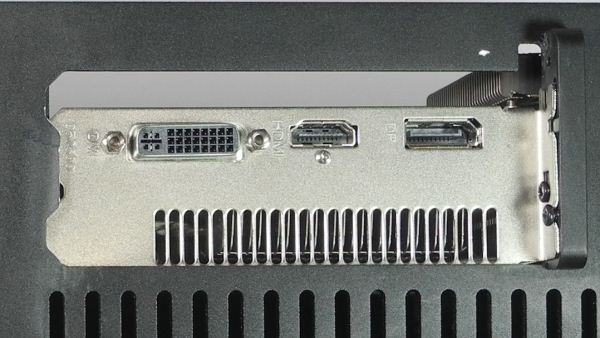Streacom's FC10 and Nano150: Building a Fanless Ivy Bridge HTPC
by Ganesh T S on December 22, 2012 3:30 AM EST- Posted in
- HTPC
- Fanless
- Ivy Bridge
Passive Build Chassis & PSU
Streacom FC10 Premium HTPC ATX Chassis:
The FC10 comes in a plain, but, easy to carry around package. The sophisticated appearance of the package belies the fact that it just contains a computer case. The internals of the package are neatly laid out, with the heat conduction plates, pipes and other miscellaneous components in one box and a detailed assembly manual on top of it.
Describing the chassis itself as a thing of beauty would be an understatement. Our sample unit came in black (silver is also available). The chassis is made of solid aluminium and has a sandblasted finish lending it a premium look. After taking a look at the case, I can say that Streacom isn't exaggerating when they claim that the FC10 is a 'work of art combining form and function'.
The hard drive bays support up to 2 x 3.5" and 3 x 2.5" drives. There is also a slim slot loading optical drive slot. There are two USB ports on the side. We also have the option to add an IR receiver to the system. The unit also has a slot to place one of the Streacom PSUs which come in 150, 180 and 250W varieties. The chassis measures 435 x 319 x 100mm and weighs 5.4 Kgs.
The FC10 chassis cooling solution support both AMD and Intel CPUs.
The cooling solution consists of two components, the fins on the chassis and the heat pipes to take the heat away from the processor surface.
The chassis fins contribute to the cooling through convection by natural airflow. The heat pipes contribute through cooling by phase change, i.e, liquid water in the heat pipes close to the processor evaporates and moves towards the chassis fins where it condenses and gets transported back closer to the processor.
Inside the chassis, we have plenty of space and even two PCIe slots. The PCIe cards have to be mounted with flexible risers. Unfortunately, here is where we encountered our first issue with the FC10. Streacom went in for non-standard spacing between the two PCIe slots. This rules out the usage of dual-slot cards in the system. Streacom came back to us with the reasoning that having the 2 slots at the normal width would have left the dividing strip too thin and weak because of the all-aluminium chassis.
Dual Slot GPU Compatibility
One of our reasons for going with the FC10 fanless chassis was to use it as a HTPC GPU testbed too. I have long since held the view that any HTPC GPU worth its salt had to come in a passive version from at least one AIB vendor. In 2012, we are at a stage where the integrated GPUs in Trinity and Ivy Bridge are more than enough for average HTPC users.
In order for users to get any meaningful HTPC capability not provided by Trinity and Ivy Bridge, a moderately powerful GPU such as the AMD 7750 or the NVIDIA GT 640 is needed. Unfortunately, their passive versions come in dual slot varieties. Not ones to be deterred by the original chassis design, we set out to fix this 'issue' (even though it is a non-issue for the majority of the builders out there). With the help of a rotary tool, it was trivial to take out the offending metal strip and polish and buff the edges. We had a little bit of trouble aligning the second fin inside the chassis, but carefully screwing in the metal plate ensured that the GPU was mounted in a stable manner.
We will be looking at this configuration in detail in the third part of the series, but it should suffice to mention here that the arrangement worked fine in operation throughout. Another minor issue is the range of PSU ratings available. Users going in for a ATX board are not going to be happy with the maximum available 250 W PSU. Streacom indicated that ATX compatibility was mentioned only because the size of the chassis allowed it. However, they expect end-users to use either mITX or uATX motherboards only.
Nano150 Fanless PSU
The Nano150 fanless PSU consists of two major components, the power brick AC / DC adapter and the power delivery module which slots inside the chassis. The power brick output is rated for 12.5A at 12V and operates in the 100 - 240V / 50 - 60Hz range. The bundled power plug was of the EU variety. It isn't much of an issue as the power plug is detachable. In any case, travel adapters are quite cheap. An alternate power cable is probably the better way to go about it if you are not in the EU. In any case, local resellers are bound to include the correct power plug.
The power brick hooks up to the power delivery module through a hole in the chassis. The module plugs directly into the 24-pin ATX power connected on the motherboard. The add-on cable set plugging into the module includes a 4-pin power connector, a molex connector and two SATA power connectors.




























63 Comments
View All Comments
Dux - Monday, December 24, 2012 - link
I'm not a shill first off. The one thing I learned over an entire week is that unless u gots money to burn prepare for lots of compromise. My build Nmedia case (matches my amplifier in size; accomodates full size GPUs), Pentium G620, midrange biostar board (I had a spare courtesy of Amazon last year), HD 5450 passive and 4 WD EcoGreen 2TB HDDs. The loudest components in order: HDDs (even with only 1 "awake"), the CPU fan (stock, slowed to 1000RPM), old silverstone 120mm blowing across the HDDs and then its a toss up between the el cheapo 120mm that came with the case and the 2 60mm fans that came with the case. Yes, the el cheapos were the most quiet lol! The issue? The HD 5450 gets too hot and is slowly coming undone. After light testing with temps never going above 70c the clock speed control is lost and the temp sensor has disappeared. Why am I not using the HD3000 GPU? There is a CLEAR difference in image quality vs my GTX 260 or the HD5450. Trust me. On a 135 in projector screen u can tell: color, grainyness, pixelization etc etc even on BR rips. U can keep Intel graphics...FYI: the G620 is boss. If u lock it in at 1.6ghz it will use only 3.88W under load. Temps never went above 130 under any conditions. Most of the time it used less than 1 watt during normal HTPC operations. I would say u could expect temps around 120F with the stock cooler. The HD5450 operated at around 150 most of the time. I understand it cant run at idle speeds (157mhz) while rendering vid. But I couldnt lock it in at 400mhz. Even rendering low quality Xvid would cause it to jump to 650mhz. The temps would theoretically climb to no end I imagine. HDDs operated at around 108F and never went above 120F. Chipset temps hovered around 110. Besides the GPU none of these temps are an issue. But I still need a CPU fan and at least some air going across my GPU heat sink.
Bottom line: u cant go passive using traditional set ups like mine. If I had it to do all over again (and I didnt have a spare socket 1155 mobo sitting around) I would have gotten a low end Trinity and bought an aftermarket 120mm CPU fan and then just slowed it down to around 1000rpm
Dux - Monday, December 24, 2012 - link
Additional insights: If you HAVE to go with a discrete passive GPU know this: my CPU uses 3.88W and still requires some air (yes, I tried a case mounted 120mm on top of it and couldnt get the temps stabilized). If you think a 19W HD5450 is truly passive you are being mislead. There has to be some air going over it (I dont have that option with my HTPC case). Buy the card with the BIGGEST heatsink possible. No, newegg doesnt carry a 5450 with anything other than the ones with a heatsink the size of a credit card and about as thick as a Mr Goodbar. No bueno (eventually). Oh well, it was a $25 card.Oh, the audio via HDMI on my GPU also pooped the bed. Thats how I know the temps are screwing with it.
Go Nvidia (need special drivers for sound via HDMI). Riva tuner is quite reliable at slowing down the GPU fan and is quite stable. My 9500GT and GTX 260 were near silent with the fans at 25%. Plus Riva tuner does a good job at underclocking (which only dropped temps 3 degrees F against stock speeds in case ur wondering).
BEWARE OF FAN CONTROLLERS!!! The bigger the fan the more voltage it requires to..."turn over". So if u have a fan controller that turns the fans completely off u wont be able to set the control knob and leave it be. Each and every time u wake the HTPC or boot it you will have to ensure your fans are spinning. If not you could get a nasty surprise. Also, some fan controllers (no way of telling I guess) will create a nasty buzzing sound on some types of fans. Hint: Logisys.... Some fans sounded like they were getting castrated. Others were barely audible. But I could tell and thats all that matters. Best $22 spent. Ever....
Newer model Corsair TX series power supplies are useful if passive Power supplies scare you (thats me). They spin up and shut down until they reach 40% load or temps get high. When running they are still near silent anyways so...
Speedfan kept "pinging" my HDDs when taking a SMART reading causing 2-3 sec "lockups" even with SMART disabled thru the BIOS. But speedfan in the only show in town from what I hear.
Dux - Monday, December 24, 2012 - link
Last comment: after all this experimenting and tweaking and drilling and testing and benchmarking and screwing around.... I finally set everything up, disconnected the HTPC from my monitor and connected it to my projector. Then I turned the projector on. Then I realized the bastard is far louder than any computer made since the Pentium 4 dual cores. Think about that if you have a projector and are thinking of plunking down some solid coin on a "silent" HTPC. Not worth it friends.randinspace - Thursday, December 27, 2012 - link
LOL. I feel your pain. It's winter here, and the very moment I'd finished ordering up the remaining parts for a "silent" build the heat came on and I was reminded just how noisy the central air is in the dump I live in.cerietke - Monday, December 24, 2012 - link
AMD's Trinity processors get considerably hotter than Intel's in a comparable setup. If you would want to test this passive case's ability to keep the CPU cool it might be a much bigger challenge for it if you use a Trinity processor.I have an FC5-EVO case myself with an A10-5700 inside that gets quite hot (nearly 80 C). Streacom has sent a replacement heatsink and heatpipes (after a lot of e-mails), but so far I am not seeing improvements. Of course possibly I made a mistake in the building process or another component of the system could perhaps be to blame, but the fact is that these do get hotter and will therefore be a better test of the passive cooling.
ypsylon - Monday, December 24, 2012 - link
I consider any case (or LCD, scanner, etc...) which requires external PSU in todays day and age absolute disgrace. There is no excuse for that, it is not like there are no passive PSUs available around.cjs150 - Monday, December 24, 2012 - link
If not playing new games, there is little need for a discrete GPU for an HTPC.Personally I would prefer the passive cases had a slow running fan on top with dust filters, but having built a passive HTPC, they do work very well without fans. My i7-3770T spends most of its time at 40-45C (room temp is 22C), it would almost certainly be less if took off the IHS and replaced the shoddy Intel thermal grease. Even if I run Prime for 30mins max temperatures is 90C which is well under thermal specs, and you are unlikely to be at 100% load on an HTPC. I picked the i7-3770T because whilst expensive it has the lowest TDP of CPUs with Intel 4000 graphics
One thing which none of the passive case makers get right is the ODD cage. No one includes some proper anti-vibration dampening. It would make a massive difference.
Nice to see Ganesh also stores all his media on a separate NAS. Shame Microsoft has made the decision that Windows 8 will not support separate NAS (unless part of active domain and a truly horrible fudge) at least not as far as the libraries function is concerned..
Microsoft has basically abandoned the HTPC market (Windows 8 has no support for TV Tuner cards, no native DVD or Blu Ray playback, libraries is an issue if using a NAS) even though Windows 8 interface works very well on an HTPC and Linux not ready to pick it up. When Linux gets ability to play commercial Blu Rays then XBMC and Linux will be the way to go.
Despite all the problems I am very happy with the HTPC I built (Hdplex case)
MadMan007 - Monday, December 24, 2012 - link
I don't like that sooo many cases like this come with slim optical drive mounts, and on top of that they are often slot-loading $$$. There is space even in a case like this for a full-size optical which gives you a ton of choices and much better prices, especially versus slot-loading. I know that optical is on its way out for PCs (even though I and lots of others still rip their media) but in a large HTPC case where it's possible - unlike the ultra-SFF HTPC cases -an optical is needed even more than a desktop or laptop because of bluray.mr_tawan - Friday, December 28, 2012 - link
Great review!. I'm now interested to build a PC with this case. Still don't know if I can find one in my country.My only suggestion - please use only one unit for a thing, eg. using only either Farenheit, Kelvin, or Celcius for temperature measurement.
Thanks.
drbo - Saturday, December 29, 2012 - link
I have a Streacom FC5, running a trinity system of A8 3870-k and Asus F1-A75-M Pro and an 240GB Intel 520 SSD. Has been run running perfect for over one year, Windows 7 64 MCE, streaming 1080p Movies and HD TV from the server in the basement, using MyMovies and DVBLink. No problems with temperatures getting to hot.Streacom fan less cabinets are absolute fabolous, BUT their remote option is junk and mot MCE compatible, so I advice all to stay away from that one, and rather pick up an old windows MCE remote, especially if you are using the TV option of the HTPC.